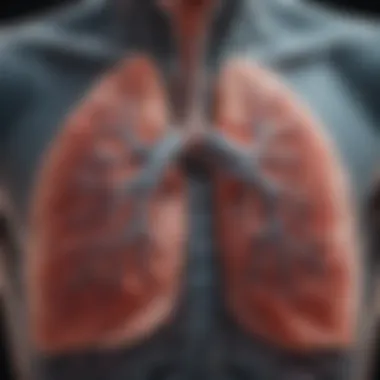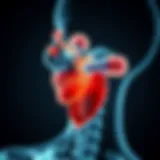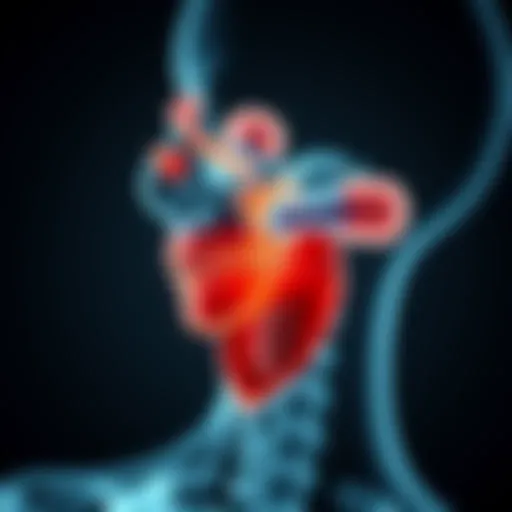Understanding Life Expectancy with Emphysema


Intro
Emphysema is a progressive lung condition that falls under the category of chronic obstructive pulmonary disease (COPD). Its impact on life expectancy is a vital topic, particularly for patients, families, and healthcare professionals. Understanding how emphysema affects longevity involves examining numerous factors, ranging from individual health status to broader lifestyle choices.
Many people are unaware of how strongly their daily habits, comorbid conditions, and genetic predispositions can shape their experience with this disease. Emphysema leads to the gradual destruction of air sacs in the lungs, compromising the ability to breathe effectively. Symptoms such as chronic cough, wheezing, and breathlessness often escalate as the disease progresses, significantly affecting quality of life. Thus, a clear grasp on the variable elements such as age, smoking history, and overall health can make a remarkable difference in life expectancy.
This article seeks to provide a comprehensive overview of emphysema's implications on life expectancy, detailing how managing the disease can influence outcomes. By addressing both the symptoms and treatment options, this guide aims to enlighten the target audience on the realities of living with emphysema.
Prelude to Emphysema
Emphysema represents a significant health challenge, particularly for those grappling with chronic respiratory issues. This section aims to unveil the intricacies associated with emphysema, laying the groundwork for understanding its implications on life expectancy. It will outline the essential elements of emphysema, its definition, and the ways in which it develops. By framing these fundamental concepts, readers can appreciate the following discourse on how emphysema affects one's life span and overall health.
Definition and Overview
Emphysema is a chronic lung condition that belongs to a broader category known as chronic obstructive pulmonary disease (COPD). It is characterized by the gradual destruction of the alveoli or air sacs in the lungs. This destruction hampers the lungs' ability to transfer air into the bloodstream, leading to breathing difficulties. The disease is typically progressive, meaning symptoms worsen over time, often contributing to a diminished quality of life for those affected. According to various health sources, including the World Health Organization, emphysema is often linked to environmental factors, particularly long-term exposure to cigarette smoke and inhalation of pollutants.
Emphysema is a complex disease that requires a multi-faceted approach for its understanding and management.
How Emphysema Develops
The development of emphysema is often a gradual process influenced by genetic and environmental factors. Most commonly, it occurs following prolonged exposure to irritants that damage lung tissues. Smoking is the leading cause, but other factors can play a role, such as genetic mutations that affect lung function or exposure to harmful occupational substances. The initial stages of emphysema often go unnoticed, as the body compensates for lost lung function, allowing individuals to breathe normally at rest. However, as the disease progresses, the situation changes. Patients may begin to experience shortness of breath during physical activities which eventually extends to even minor tasks. Understanding how emphysema develops illuminates the importance of early detection and intervention. This knowledge helps in managing the condition more effectively and may extend life expectancy for many individuals.
Understanding Life Expectancy
Understanding life expectancy with emphysema is a critical aspect of managing this chronic lung disease. Life expectancy serves not only as a measure of how long individuals with emphysema may live but also indicates the overall quality of life they might experience as they navigate this condition. Comprehending the factors that influence life expectancy allows patients and their caregivers to make informed decisions about treatment, lifestyle modifications, and preventive measures. In this article section, we will dissect key elements that pertain to life expectancy in emphysema, providing insights that can aid in better management of the disease.
Factors Influencing Life Expectancy
The various factors influencing life expectancy in those with emphysema form a complex web that dictates each individual’s health trajectory. Understanding these factors can significantly alter the course of a patient's management plan.
Age
Age significantly affects life expectancy in patients with emphysema. As people grow older, the body naturally experiences wear and tear. This decline often compounds the effects of emphysema, leading to a reduced life expectancy. Younger patients tend to have a better physiological reserve, allowing for more effective treatment outcomes and better management of the disease. Therefore, younger age exemplifies a beneficial characteristic for long-term health in emphysema patients. However, age also brings potential comorbidities that may influence overall health negatively. This duality makes age a critical focus in understanding life expectancy.
Smoking History
Smoking history stands as one of the most crucial factors determining prognosis in emphysema patients. Many patients with emphysema have a significant history of tobacco use. This establishes a direct link between smoking and the severity of the disease. Those who quit smoking typically see a more favorable prognosis, as the body begins to heal once the exposure to harmful substances ceases. Thus, the action of quitting creates an opportunity for improved health outcomes. However, continuous smoking can exacerbate emphysema's symptoms and progress the disease, contributing to a lower life expectancy.
Comorbid Conditions
Comorbid conditions such as heart disease, diabetes, and COPD complicate disease management and impact life expectancy considerably. When emphysema coexists with these conditions, it can lead to poorer health outcomes, as the body's ability to cope diminishes. The presence of multiple health issues increases the complexity of treatment and reduces the patient's overall resilience. For this reason, monitoring and addressing any comorbid conditions is essential for extending life expectancy in emphysema sufferers. Understanding how these conditions interplay with emphysema helps tailor more effective management strategies.
Treatment Adherence
Treatment adherence plays a pivotal role in determining life expectancy for people with emphysema. Following prescribed medications, participating in pulmonary rehabilitation, and attending regular medical appointments can significantly improve health outcomes. Adherence can enhance lung function, reduce exacerbation of symptoms, and increase overall stability of health. On the contrary, non-adherence can lead to worsening of the disease and escalated complications, thereby decreasing life expectancy. Hence, encouraging patients to follow their treatment plans closely is crucial for achieving optimal health.
Statistical Data on Emphysema Life Expectancy
Statistical data provides a clearer picture of life expectancy associated with emphysema. Studies indicate that average life expectancy can vary widely depending on the above factors. While many patients live several years after diagnosis, significant variations exist based on severity, treatment, and individual circumstances. A finer understanding of these data points can aid in setting realistic expectations and aligning treatment goals. Additionally, ongoing research continues to fill gaps in knowledge, further elucidating these trends.
Overall, understanding life expectancy in emphysema demands a multidimensional approach to patient care, incorporating these critical factors into discussions about health and future planning.
Stages of Emphysema
Understanding the stages of emphysema is crucial for both patients and healthcare providers. The severity of this condition directly impacts the symptoms experienced and the treatment options available. Each stage reflects changes in lung function, influencing life expectancy and quality of life. Recognizing the stage helps in tailoring management strategies and the necessity of follow-up care.


Mild Stage
In the mild stage of emphysema, patients may not experience significant symptoms. At this point, lung function is often still relatively preserved. A common finding is mild shortness of breath, especially during physical activities.
Patients might not even be aware they have emphysema. Diagnostic tools such as spirometry can reveal reduced lung function, although patients are usually asymptomatic. Early intervention during this stage may include recommending lifestyle changes. Smoking cessation is critically important, as it can slow progression significantly. Monitoring symptoms and maintaining regular check-ups will help ensure that management can adapt if the condition worsens.
Moderate Stage
As the disease progresses to the moderate stage, symptoms become more apparent. Patients often experience increased shortness of breath, even during daily tasks, leading to reduced activity levels. The body’s ability to compensate for diminished lung function declines.
Exacerbations, or flare-ups, may occur more frequently. Patients may benefit from medications such as bronchodilators. Pulmonary rehabilitation can be effective at this stage, as it provides exercises tailored to improve lung function. Education about managing symptoms and recognition of exacerbations becomes essential. Regular follow-up care ensures the treatment is effective and can adapt as needed.
Severe Stage
In the severe stage of emphysema, symptoms reach a significant impact on daily life. Shortness of breath can occur at rest, and daily tasks become challenging. Lung function is greatly compromised, leading to increased fatigue.
This stage often sees patients needing supplemental oxygen to relieve symptoms and improve quality of life. Comorbid conditions such as cardiovascular disease may also emerge. Treatment should focus on managing these comorbidities alongside the emphysema. Palliative care options should also be discussed, ensuring that patients have support for their quality of life concerns.
Very Severe Stage
The very severe stage represents the end of the spectrum for emphysema. Lung function is critically low, and the burden of symptoms is profound. Patients often experience severe limitations in physical activity and may feel breathless even at rest.
At this point, patients may require advanced treatments, including lung volume reduction surgery or even lung transplantation. Psychological support becomes vital, addressing the emotional toll of the illness. Discussions around end-of-life care planning can also be important. Recognizing the stage aids in emphasizing the need for comprehensive care management, maximizing comfort and support during this challenging period.
"Understanding the stages of emphysema is essential for appropriate treatment planning and patient education."
Symptoms and Their Impact
Understanding the symptoms of emphysema is crucial for both patients and caregivers. Emphysema presents various challenges that can profoundly alter one’s quality of life. Knowledge of common symptoms can aid in recognizing disease progression and addressing immediate needs. Additionally, understanding these symptoms enhances communication with healthcare providers. This section will delve into the common symptoms experienced by those with emphysema and discuss their broader impact on daily life.
Common Symptoms of Emphysema
Emphysema primarily affects the lungs, leading to a range of symptoms. Some of the more prevalent symptoms include:
- Shortness of breath: This is often one of the first and most debilitating symptoms. As the condition progresses, physical activities become increasingly difficult.
- Chronic cough: Many patients experience a persistent cough that is often associated with the production of mucus.
- Wheezing: This high-pitched sound during breathing indicates narrowing airways and can be distressing.
- Chest tightness: Patients frequently report discomfort or a feeling of constriction within the chest.
- Fatigue: Even mild day-to-day tasks can cause exhaustion. This is due to reduced oxygen levels and the energy required for breathing.
- Cyanosis: In severe cases, the skin, especially the lips and fingertips, may turn bluish, indicating low oxygen levels.
These symptoms vary among individuals, but recognizing them is essential for timely intervention.
Burden of Symptoms on Daily Life
The impact of emphysema symptoms extends beyond the physical realm; they can significantly compromise one’s overall quality of life. Individuals may face the following challenges:
- Limitations on Activities: Due to breathlessness, most patients avoid physical activities, leading to a sedentary lifestyle. This can contribute to weight gain and further health complications.
- Mental Health Issues: Anxiety and depression frequently occur alongside chronic respiratory conditions. The constant worry about breathing difficulties can lead to social withdrawal and isolation.
- Work Limitations: Many individuals find it hard to maintain employment due to their symptoms. This can result in financial strain and a loss of social identity.
- Increased Healthcare Needs: Frequent doctor visits and treatments become part of life for many patients, leading to a burden on both time and finances.
- Family Impact: The symptoms of emphysema can affect family dynamics, as loved ones must often adjust their routines to accommodate the needs of the patient.
The burden of emphysema transcends physical symptoms, affecting emotional well-being and social interactions.
Understanding these challenges can facilitate better treatment planning and support. It is vital for patients, caregivers, and healthcare professionals to address both the physical and emotional aspects of the disease. Recognizing the impact of symptoms ultimately fosters a more comprehensive approach to care, enhancing life quality for those with emphysema.
Treatment Options for Emphysema
Understanding the treatment options for emphysema is crucial for optimizing patient outcomes and enhancing overall life quality. Emphysema is a debilitating condition that can severely restrict breathing and daily activities. Therefore, selecting effective treatment strategies is essential. Proper treatment not only helps manage symptoms but also slows disease progression, potentially extending life expectancy. This section outlines the principal treatment modalities: medications, pulmonary rehabilitation, and surgical interventions, each with unique benefits and considerations.
Medications
Medications play a central role in managing emphysema, primarily aimed at easing symptoms and preventing complications. Bronchodilators are often prescribed, helping to relax the muscles surrounding the airways, making breathing easier. Corticosteroids can reduce inflammation in the lungs, providing additional relief. Combination inhalers that include both bronchodilators and steroids may also be used for more significant effect. It is vital for patients to adhere to prescribed medication regimens, as consistent use can significantly improve lung function and quality of life.
Pulmonary Rehabilitation


Pulmonary rehabilitation is a multidisciplinary program that encompasses exercise training, education, and support to help individuals manage their condition. This program is tailored to the patient's needs and aims to improve physical and emotional well-being. The benefits of pulmonary rehabilitation include enhanced physical fitness, reduced symptom severity, and improved daily functioning. Patients often learn techniques for effective breathing, which can alleviate breathlessness during physical activities. In addition, the supportive environment fosters community, helping patients manage the psychosocial aspects of living with emphysema.
Surgical Interventions
Surgical interventions are considered for severe cases of emphysema where standard treatments are insufficient. Two types of surgery are notably relevant for emphysema patients: Lung Volume Reduction Surgery and Lung Transplantation.
Lung Volume Reduction Surgery
Lung Volume Reduction Surgery (LVRS) involves removing diseased portions of the lung to allow the healthy tissue to expand more effectively. This surgery is particularly beneficial for patients with the heterogeneous type of emphysema. Key characteristics include its potential to improve lung function and enhance quality of life. Patients report reduced shortness of breath and greater physical activity levels following the procedure. However, LVRS is not suitable for everyone. Candidates must meet specific health criteria, and the operation carries inherent risks, including complications from surgery.
Lung Transplantation
Lung Transplantation is another viable, although more drastic, option for individuals with end-stage emphysema. This procedure involves replacing severely damaged lungs with healthy ones from a donor. The primary advantage of lung transplantation is the substantial improvement in lung function and life expectancy it can offer. However, the unique feature of this intervention is the reliance on a suitable donor, which can lead to long waiting periods. Furthermore, patients must adhere to lifelong immunosuppressive therapy to prevent organ rejection, which introduces the risk of infections and other complications.
"Decisions regarding surgical interventions should always be made in consultation with a healthcare provider familiar with the unique aspects of each patient's condition."
Lifestyle Modifications and Their Importance
Lifestyle modifications play a critical role in managing emphysema and enhancing life expectancy. Patients often face a myriad of challenges due to this chronic lung disease, making it essential to adjust one’s daily habits. Each modification can have significant implications on overall health and quality of life. This section will outline three key aspects: smoking cessation, nutrition, and exercise regimens, all of which are fundamental to optimizing health outcomes for individuals living with emphysema.
Smoking Cessation
Smoking cessation is arguably the most vital lifestyle change for someone with emphysema. The act of quitting can lead to a notable improvement in lung function. Research indicates that former smokers experience a reduced decline in lung capacity compared to those who continue smoking.
- Initial Challenges: Quitting smoking is often accompanied by withdrawal symptoms, making it a challenging endeavor. However, "the benefits far outweigh the temporary discomforts."
- Support Mechanisms: Utilizing resources such as quitlines or support groups can significantly increase the chances of success. Medications like varenicline or bupropion may also assist in this transition.
- Long-Term Benefits: Becoming smoke-free not only slows the progression of emphysema but can also reduce the risk of developing other health-related issues, including heart diseases.
Nutrition and Its Role
Nutrition is essential for maintaining optimal health and managing emphysema. A well-rounded diet supports the immune system and can improve energy levels, making daily activities more manageable for patients. Proper nutrition is particularly important as weight loss is a common issue in those with chronic lung diseases due to increased energy expenditure.
- Balanced Diet: A diet rich in fruits, vegetables, whole grains, and lean proteins is recommended. Vitamins and antioxidants can help manage inflammation.
- Avoiding Certain Foods: Patients should be cautious about high-sodium and processed foods which may worsen breathlessness or bloating.
- Hydration: Staying hydrated aids in thinning mucus, making it easier to clear from the lungs. Proper fluid intake is often overlooked but is fundamental in managing symptoms effectively.
Exercise Regimens
Regular exercise plays a crucial role in enhancing lung capacity and overall physical endurance. While emphysema can pose challenges to maintaining an active lifestyle, tailored exercise programs can empower patients significantly.
- Breathing Exercises: Techniques such as pursed-lip breathing can provide immediate benefits by helping to control breathlessness.
- Moderate Physical Activity: Activities such as walking or swimming can improve cardiovascular fitness. Aim for at least 30 minutes of moderate exercise most days of the week, if feasible.
- Supervised Programs: Engaging in pulmonary rehabilitation programs can be beneficial. These programs offer structured guidance and support, allowing patients to exercise within their capabilities in a safe environment.
"Adopting beneficial lifestyle changes can transform the management of emphysema, influencing health trajectories positively."
Psychosocial Factors
Psychosocial factors play a crucial role in the lives of individuals with emphysema. These factors influence not only mental health but also overall well-being and patient adherence to treatment. Understanding the psychosocial landscape can help patients manage their conditions more effectively and enhance their quality of life.
Mental Health Considerations
Mental health considerations are particularly significant for patients with emphysema. The burden of chronic illness can lead to feelings of depression, anxiety, and stress. Research shows that these mental health issues are common among people with respiratory diseases. For instance, a study published by the American Journal of Respiratory and Critical Care Medicine highlights that up to 40% of emphysema patients experience depression. Effective management of mental health is important because:
- It can improve treatment adherence. When patients feel mentally supported, they are more likely to follow through with their medication and rehabilitation programs.
- It reduces the risk of comorbid conditions. Anxiety and depression can lead to a decline in physical health, exacerbating symptoms of emphysema.
- It enhances the quality of life. Addressing mental health needs can lead to a more fulfilling daily experience.
Support Systems and Their Role
Support systems, which include family, friends, and healthcare professionals, are essential for patients with emphysema. These systems provide emotional, practical, and informational support. Family members can assist in managing daily tasks, while friends can offer companionship, which is vital when someone faces the isolation that often accompanies chronic illnesses. The role of support systems includes:
- Providing emotional comfort. It is important for patients to have someone to talk to about their experiences and feelings. This can alleviate feelings of loneliness.
- Encouraging adherence to treatment. Having a supportive partner or friend can motivate patients to engage more actively in their health management strategies, like taking medication on time or attending rehabilitation sessions.
- Facilitating communication with healthcare providers. Strong support can help patients articulate their needs or concerns during medical visits, leading to better personalized care.


Regular Monitoring and Follow-Up Care
Regular monitoring and follow-up care are essential components in managing emphysema effectively. They help patients keep track of their condition, monitor symptoms, and adjust treatment plans as necessary. This is crucial because emphysema is a progressive disease, meaning it can worsen over time. By regularly assessing the patient's health, healthcare providers can make informed decisions about interventions and lifestyle adjustments.
Importance of Regular Check-Ups
Regular check-ups serve multiple purposes in the context of emphysema management. They allow doctors to evaluate lung function through tests such as spirometry, which measures how much air one can exhale and how quickly. This information is vital to understanding the stage of emphysema and guiding treatment options.
Moreover, check-ups help identify any potential comorbid conditions, such as heart disease or diabetes, that may arise in emphysema patients. Detecting these issues early can lead to better management and significantly impact life expectancy.
Follow-up appointments also provide opportunities for healthcare providers to educate patients on the importance of adherence to treatment plans. Whether it includes medications, pulmonary rehabilitation, or smoking cessation, regular engagement with healthcare professionals reinforces the necessity of these interventions.
It's important for patients to discuss any changes in their symptoms during these check-ups. Changes can include increased shortness of breath, fatigue, or cough. Addressing these symptoms immediately can prevent worsened conditions and inform necessary treatment changes.
Key benefits of regular monitoring and follow-up care:
- Timely intervention to address complications.
- Enhanced personalized treatment plans based on current health status.
- Opportunity for patient education regarding self-management strategies.
In summary, regular check-ups are not merely routine; they are vital to managing emphysema and improving life expectancy. By prioritizing these appointments, patients can take active roles in their health management while closely collaborating with healthcare providers.
Future Perspectives in Emphysema Research
The realm of emphysema research is evolving, with ongoing studies aiming to enhance patient outcomes and quality of life. Understanding future perspectives in this area is essential, as it could yield breakthroughs that transform how the disease is managed. Continuous investigation into emphysema can potentially lead to innovative treatment options, improve early detection methods, and expand our understanding of the disease mechanisms involved.
Innovations in Treatment Approaches
Innovations in treatment approaches for emphysema are critical for enhancing life expectancy and overall well-being. Current treatments, while somewhat effective, can be improved through research that focuses on novel therapies. This includes advancements in drug development, such as targeted therapies that address specific pathways involved in emphysema progression.
Moreover, emerging technologies, such as gene therapy, show promise in treating lung diseases. Gene editing techniques, like CRISPR, could potentially correct defects in gene expression that contribute to emphysema. This approach could revolutionize management strategies by targeting the root causes rather than just alleviating symptoms.
Robotic-assisted surgeries for lung volume reduction is another avenue being explored, offering patients less invasive options with faster recovery times. Research efforts are also investigating the role of biologics in emphysema treatment, which could lead to less reliance on steroids and other traditional medications.
Potential for Advances in Understanding Disease Mechanisms
A deeper understanding of the mechanisms underlying emphysema is crucial. Research is currently focusing on the genetic, environmental, and lifestyle factors that contribute to disease development and progression. By unraveling these complexities, researchers can identify potential biomarkers that may serve as indicators for disease severity and response to treatment.
The role of inflammation and oxidative stress is under investigation. These processes are known to significantly impact lung function and overall health in individuals with emphysema. Uncovering how these factors interact with genetic predispositions may lead to personalized treatment plans tailored to each patient's needs.
The integration of data science and artificial intelligence in tracking disease patterns can also offer valuable insights. By analyzing large datasets, researchers can identify trends and predictors of outcomes, enhancing patient care.
Future advancements in emphysema research may not only improve treatment but also redefine how patients manage their lives with this chronic condition while providing a clearer insight into their prognosis.
The End
The conclusion serves as a vital synthesis of the insights gathered throughout the article regarding emphysema and its impact on life expectancy. Understanding the interplay of various factors such as age, smoking history, and comorbid conditions is essential for patients and caregivers navigating this condition. It distills complex information into actionable knowledge, making it easier for individuals to grasp how one can optimize their health outcomes despite a diagnosis of emphysema.
Summary of Key Points
In summary, the article has highlighted several critical elements that affect life expectancy in patients with emphysema:
- Disease Stages: The severity of emphysema directly correlates with prognosis. Early intervention can significantly alter outcomes.
- Lifestyle Choices: Smoking cessation remains paramount. Changes in diet and exercise can also influence overall health.
- Treatment Accessibility: Access to medications, pulmonary rehabilitation, and surgical options enhances quality of life and extends longevity.
- Psychosocial Support: Emotional and psychological health cannot be neglected. It plays a role in managing symptoms and improving life expectancy.
Understanding these factors allows for informed decisions about health management and enhances the quality of life for those affected by emphysema.
Call to Action for Patients and Caregivers
It is crucial for patients and caregivers to take proactive steps in managing emphysema. Here are some recommendations to consider:
- Engage Continuously with Healthcare Providers: Regular check-ups and open communication help in fine-tuning treatment plans that suit individual needs.
- Focus on Lifestyle Changes: Implementing changes like quitting smoking, enhancing nutrition, and engaging in physical activity can significantly impact health outcomes.
- Seek Psychological Support: Exploring resources for mental health can provide coping strategies to deal with the emotional burden of chronic illness.
- Join Support Groups: Connecting with others facing similar challenges can offer both emotional relief and practical advice.
"Knowledge is power. Understanding your condition enables you to advocate for your health effectively."
By staying informed and committed to self-care, patients can navigate the complexities of emphysema more effectively and improve their overall life expectancy.







